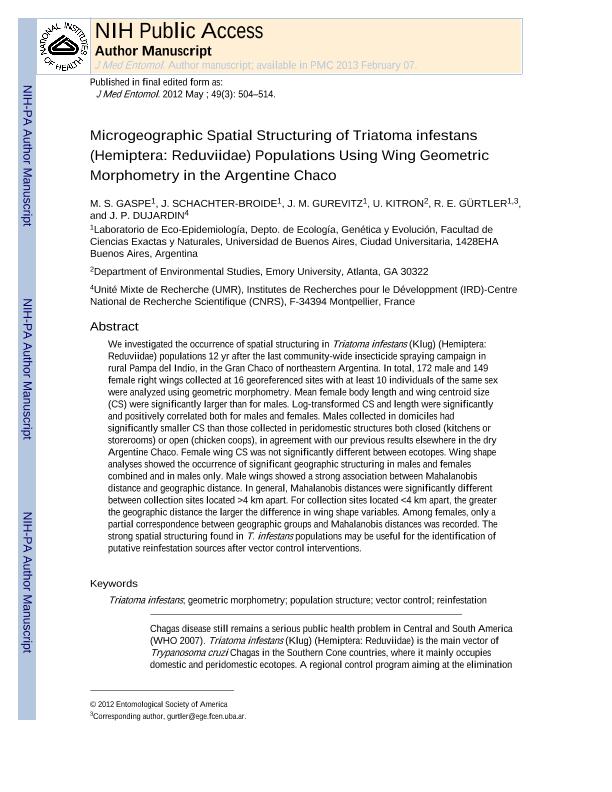Mostrar el registro sencillo del ítem
dc.contributor.author
Gaspe, Maria Sol

dc.contributor.author
Schachter Broide, Martín

dc.contributor.author
Gurevitz, Juan Manuel

dc.contributor.author
Kitron, Uriel
dc.contributor.author
Gurtler, Ricardo Esteban

dc.contributor.author
Dujardin, Jean Pierre
dc.date.available
2019-01-25T21:07:45Z
dc.date.issued
2012-05
dc.identifier.citation
Gaspe, Maria Sol; Schachter Broide, Martín; Gurevitz, Juan Manuel; Kitron, Uriel; Gurtler, Ricardo Esteban; et al.; Microgeographic spatial structuring of Triatoma infestans (Hemiptera: Reduviidae) populations using wing geometric morphometry in the Argentine Chaco; Entomological Society of America; Journal of Medical Entomology; 49; 3; 5-2012; 504-514
dc.identifier.issn
0022-2585
dc.identifier.uri
http://hdl.handle.net/11336/68683
dc.description.abstract
We investigated the occurrence of spatial structuring in Triatoma infestans (Klug) (Hemiptera: Reduviidae) populations 12 yr after the last community-wide insecticide spraying campaign in rural Pampa del Indio, in the Gran Chaco of northeastern Argentina. In total, 172 male and 149 female right wings collected at 16 georeferenced sites with at least 10 individuals of the same sex were analyzed using geometric morphometry. Mean female body length and wing centroid size (CS) were significantly larger than for males. Log-transformed CS and length were significantly and positively correlated both for males and females. Males collected in domiciles had significantly smaller CS than those collected in peridomestic structures both closed (kitchens or storerooms) or open (chicken coops), in agreement with our previous results elsewhere in the dry Argentine Chaco. Female wing CS was not significantly different between ecotopes. Wing shape analyses showed the occurrence of significant geographic structuring in males and females combined and in males only. Male wings showed a strong association between Mahalanobis distance and geographic distance. In general, Mahalanobis distances were significantly different between collection sites located >4 km apart. For collection sites located <4 km apart, the greater the geographic distance the larger the difference in wing shape variables. Among females, only a partial correspondence between geographic groups and Mahalanobis distances was recorded. The strong spatial structuring found in T. infestans populations may be useful for the identification of putative reinfestation sources after vector control interventions.
dc.format
application/pdf
dc.language.iso
eng
dc.publisher
Entomological Society of America

dc.rights
info:eu-repo/semantics/openAccess
dc.rights.uri
https://creativecommons.org/licenses/by-nc-sa/2.5/ar/
dc.subject
Geometric Morphometry
dc.subject
Population Structure
dc.subject
Reinfestation
dc.subject
Triatoma Infestans
dc.subject
Vector Control
dc.subject.classification
Otras Ciencias Biológicas

dc.subject.classification
Ciencias Biológicas

dc.subject.classification
CIENCIAS NATURALES Y EXACTAS

dc.title
Microgeographic spatial structuring of Triatoma infestans (Hemiptera: Reduviidae) populations using wing geometric morphometry in the Argentine Chaco
dc.type
info:eu-repo/semantics/article
dc.type
info:ar-repo/semantics/artículo
dc.type
info:eu-repo/semantics/publishedVersion
dc.date.updated
2019-01-25T13:37:41Z
dc.journal.volume
49
dc.journal.number
3
dc.journal.pagination
504-514
dc.journal.pais
Estados Unidos

dc.journal.ciudad
Lanham
dc.description.fil
Fil: Gaspe, Maria Sol. Universidad de Buenos Aires. Facultad de Ciencias Exactas y Naturales. Departamento de Ecología, Genética y Evolución. Laboratorio de Eco-Epidemiología; Argentina. Consejo Nacional de Investigaciones Científicas y Técnicas; Argentina
dc.description.fil
Fil: Schachter Broide, Martín. Universidad de Buenos Aires. Facultad de Ciencias Exactas y Naturales. Departamento de Ecología, Genética y Evolución. Laboratorio de Eco-Epidemiología; Argentina
dc.description.fil
Fil: Gurevitz, Juan Manuel. Universidad de Buenos Aires. Facultad de Ciencias Exactas y Naturales. Departamento de Ecología, Genética y Evolución. Laboratorio de Eco-Epidemiología; Argentina. Consejo Nacional de Investigaciones Científicas y Técnicas; Argentina
dc.description.fil
Fil: Kitron, Uriel. University of Emory; Estados Unidos
dc.description.fil
Fil: Gurtler, Ricardo Esteban. Universidad de Buenos Aires. Facultad de Ciencias Exactas y Naturales. Departamento de Ecología, Genética y Evolución. Laboratorio de Eco-Epidemiología; Argentina. Consejo Nacional de Investigaciones Científicas y Técnicas; Argentina
dc.description.fil
Fil: Dujardin, Jean Pierre. Centre National de la Recherche Scientifique; Francia
dc.journal.title
Journal of Medical Entomology

dc.relation.alternativeid
info:eu-repo/semantics/altIdentifier/url/https://academic.oup.com/jme/article-abstract/49/3/504/873921
dc.relation.alternativeid
info:eu-repo/semantics/altIdentifier/doi/http://dx.doi.org/10.1603/ME11176
dc.relation.alternativeid
info:eu-repo/semantics/altIdentifier/url/https://www.ncbi.nlm.nih.gov/pmc/articles/PMC3566984/
Archivos asociados
